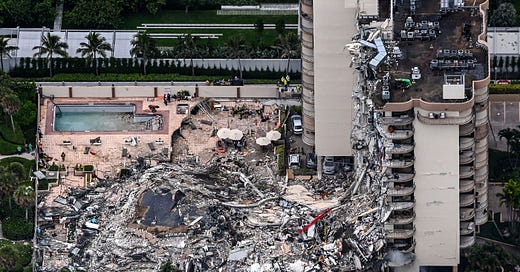The Surfside Condo Collapse: A Brief Forensic Study of Missing the Point Entirely
The greater cautionary tale sits beneath the rubble of countless other American crises. But in no way is Surfside isolated.
by Rich Herschlag
The summer has been such a barrage of cataclysmic news that the Surfside condo collapse, which killed 98 people, has itself largely been buried since occurring in late June. Since then, the focus—to the degree that there has been any—has been on what may have occurred in this one tragic instance. The greater cautionary tale sits beneath the rubble of countless other American crises. But in no way is Surfside isolated.
Within a few hours of the collapse, friends, family, and clients were texting and emailing me. They wanted to know what caused it. It was as if they were reaching out to a coroner to give a cause of death for an autopsy he has not and would never perform. I gave them and all who followed the answer no one wanted to hear. I don’t know. How could I possibly know? It’s complicated and will require many weeks of analysis.
As an independent, licensed consulting structural engineer over the past quarter century and counting, I got pretty good at recognizing the difference between a foundation that was settling and one that was cracking due to thermal expansion. Pretty decent at ferreting out a dozen or more potential failure modes and determining which two or three are most likely to contribute to serious structural problems in the future.
But I got even better at identifying the three general types of clients. Type A reads the report, discusses the findings, and stands ready to bite the cost bullet even if it means perhaps shelling out a fortune to underpin or reinforce the structure. Type B argues and dodges for a while, often seeks a second opinion, but eventually comes around to the results of a cost-benefit analysis that recognizes the costs of a ceiling falling on a room full of fifth graders. Type C believes structural engineers—as part of an ingenious scam to work 50 to 70 hours a week raking in anywhere from $40K to $110K a year—spend their time fabricating doomsday scenarios for the sheer fun of it. Type C typically makes more money than the structural engineer, has mastered structural engineering from YouTube videos, is better connected, and will seek a second, third and fourth opinion—including one from a guy who used to sell concrete—until eventually one comes up aces.
America is filled with Type Bs and Cs. The Cs, in fact, often run condo boards, banks, insurance companies, and Senate committees. Engineers, meanwhile, pile up exposure and the liability that goes with it. As a design engineer you may have hundreds of sections of the American Concrete Institute code memorized, but in the end you have little or no control over the watered down concrete mix that arrived on site the morning of March 11, 2004, the non-union trainee who formed it without sufficient cover for the steel reinforcing bar, or the building management company that in September 2017 decided not to bid out the contract for temporary shoring because the annual budget was already blown by the new marble water wall in the lobby.
We see a privately owned collapsed building in Florida and a publicly owned collapsed bridge in Minnesota as two distinct problems, but in a fundamental way they are not. In one case individuals sweep pronounced problems under the rug and show a moderate cost savings. In the other case an entire nation falls trillions of dollars off the international pace of infrastructure investment and meanwhile creates a tax incentive so a hedge fund can erect a pencil-shaped skyscraper in Manhattan with a $100 million penthouse and plumbing that leaks because the building sways in the jet stream.
Recognizing that design professionals are human, material strengths may vary, bottom line oriented CFOs may be greedy, and governments may be both strapped and short-sighted, we structural engineers have a numerical arsenal of our own. The number 1.7, for instance, pops up again and again. This is a common live load safety factor for steel and concrete, where 1.0 represents a design just barely sufficient to withstand the maximum anticipated load—be it 110 mph winds or a never used grand piano in the foyer.
Armed with such safety factors we sleep through the night a little more often than we otherwise would. But like any long established buffer baked into a corroded cake, it gets borrowed against like the trust fund of a cocaine addict. The long sad slippery slope from 1.7 down to 0.99 is paved with assurances that collapses like the one we saw in Surfside never happen. Until they do. You can bet your last linear foot of rebar the building at 8777 Collins Avenue cried out for years in the only ways it knew how—spalling concrete, settlement cracks, efflorescence along the foundation walls, doors and windows difficult to open and close.
Unless it’s hit by a bomb, a plane, or a wrecking ball, a modern reinforced concrete structure collapses very, very slowly, with only the final moments broadcast on CNN. When the sometimes inevitable result of legendary neglect occurs, actuarial tables and fiscal wizards would have you believe the repercussions are somehow spread out evenly and bearably upon people and institutions in direct proportion to their culpability. Unfortunately that is not the way either buildings or the universe works.
In the coming months we will continue to hear numerous proposals for more inspections and better methodology by structural engineers. In 21st century America we are far more comfortable with a “them” problem than an “us” problem. We may if we’re lucky see a few proposals for mandating an increase in a condo’s capital reserve or a municipality’s emergency repair fund. These measures may prevent a tragedy here and there, and that’s great. But after devoting my entire adult life to the engineering profession and often receiving less respect than an Instagram beauty influencer, my own forensic assessment is we are all on a slippery slope and may collectively already have dipped below a safety factor of 1.0.
Read an excerpt from the latest for Banter Members and get 50% off a membership today:
Texas Abortion Ban And The Rise Of Lawsuit Bounty Hunters
Texas just passed the most restrictive anti-abortion law in the nation. But it’s far worse than any ordinary ban.
by Bob Cesca
WASHINGTON, DC -- The Texas legislature, dominated by white male Trump disciples, passed the most restrictive anti-abortion law in the nation this week, effectively banning the procedure. But it’s far worse than any ordinary ban.
Not only is the (constitutional, for now) medical treatment banned after six weeks in Texas -- without exceptions for rape and incest, by the way -- but the means of enforcement creates a population of snitches, vigilantes, looky-loos, ambulance-chasers, and bounty hunters relentlessly pursuing pregnant women and their doctors. In other words, rather than reporting abortions after six weeks to law enforcement, the statute allows citizens to sue anyone making money from the abortion. And the suits can award the litigant a minimum of $10,000 -- again, minimum $10,000.
That means doctors, nurses, or even the Uber driver who chauffeurs a patient to the OB/GYN can be sued for enabling abortions. During an era in which everyone’s up in everyone else’s business most of the time, especially in public places where unspooled freakouts are becoming a daily event, this law Thanos-snaps into existence money-motivated Karens stalking and doxxing pregnant women in the hopes of a gigantic pay-day….






